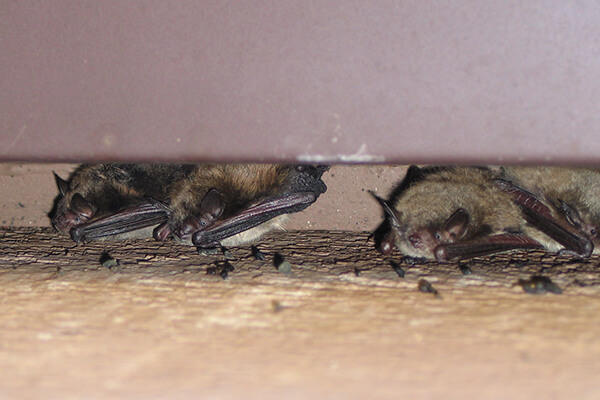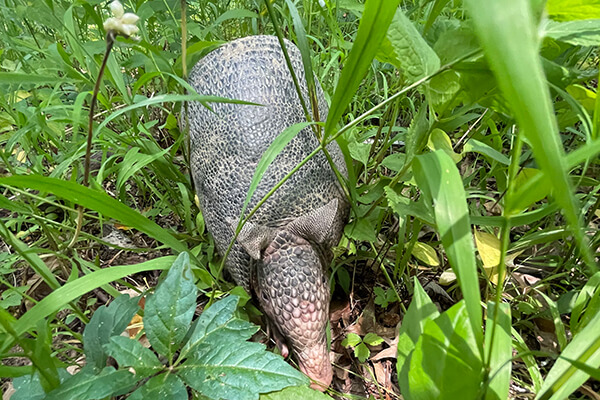
Bats in attic.
Bats
- Bats are in my attic, Aug. 16 – May 31, what can I do?
- Never handle a bat. Although it is not very common, bats are a vector species that can carry rabies.
- You can evict bats yourself, but you need to do it the right way to keep yourself and bats safe. Bat Conservation International has great information for homeowners on how to evict bats.
- Using excluding devices such as one-way doors at entry points is a safe and effective way to get bats out of your home without harming them.
- Bats will not chew, scratch, or nest. If wires, wood, or metal are being chewed through, you likely have a rodent living in the space.
- There are many wildlife control operators in the state who can assist you.
- Bats are in my attic, Jun. 1 – Aug. 15, what can I do?
- This is the season in which bats reproduce; therefore, removal is not advised until the fall when the pups are old enough to live on their own.
- Maternity season is usually between mid-June and early-August, and the pups will depend on their mothers for anywhere between 25-37 days.
- There are many wildlife control operators in the state who can assist you and can prep the area for exclusion in the fall.
- Can I evict bats during winter?
- No, bats are hibernating during this time because their food source, flying insects, is not available. Furthermore, a bat that is forced outside during the winter will likely freeze to death.
- If you find bats in your home during the winter, contact a wildlife rehabilitator or a wildlife control operator to help you safely remove and relocate the bats.
- If you find bats within the living spaces of your home during winter, they need to be removed immediately. See suggestions below.
- What if I found a bat outside my home?
- It is normal to find bats around homes from spring through fall.
- Before, during, or after extreme weather events, you may be more likely to find a bat temporarily roosting under your eves or on your house.
- Give the bat time and space. If it doesn’t leave after a few days, please contact a wildlife rehabilitator or a wildlife control operator.
- Never handle a bat. Please leave that to the professionals.
- If you come across a group of five or more freshly dead bats with intact carcasses, we ask that you safely place them in a bag (preferably with each bat in a separate bag), freeze them, and report. If you find a sick or dead bat please report it here. You may need to also contact a wildlife rehabilitator.
- I found a bat… in a room with a child, someone unable to communicate, or where someone was sleeping.
- The bat may need to be submitted for rabies testing.
- To capture a bat safely, find a sturdy box that you can punch small air holes in, then put on leather work gloves. Once the bat lands, approach the bat slowly and place the box over the bat. Then slide a rigid paper or lid between the bat and the box to trap it, then secure the box with tape.
- Contact your local health department to describe what occurred.
- I found a bat in my home, and I am certain no one has had contact with it.
- Keep people and pets out of the room with the bat.
- Isolate the bat by closing doors or openings to other rooms.
- The bat may leave if you open an external door or window, turn off all lights, and calmly wait.
- If the bat does not leave, you can safely capture the bat and release it, or contact a wildlife control operator.
- To capture a bat safely, find a sturdy box that you can punch small air holes in, then put on leather work gloves. Once the bat lands, approach the bat slowly and place the box over the bat. Then slide a rigid paper or lid between the bat and the box to trap it.
- To safely release a bat, take the box outside, set the box on its side against a tree where people and pets cannot access it, and remove the temporary lid. The bat may climb out and up the tree. If the bat does not leave, it may be dehydrated, injured, or sick – please contact a wildlife rehabilitator.
- When can I cut trees on my property without harming bats?
- You should not remove trees or branches larger than 3 inches in diameter while bats may be present from April 1 through Sept. 30.
- Additional precautions should be taken for special circumstances such as if you live near a bat hibernation site.
- To avoid harming bats, if possible, it is best to not harvest trees at all. If you do harvest, leave trees that border a stream or river, and keep any dead trees that do not pose a safety hazard. These trees can be important bat habitat.
- What kinds of trees do bats use?
- Different bat species will use different areas in a tree as habitat, and any tree could potentially be used by bats during spring, summer, and fall.
- Trees with loose bark and open cavities, such as hickories and dead snags, can be especially important habitat for the endangered Indiana bat.
- Refer to Conserving Federally Endangered Indiana Bats on Private Woodlands for additional information on the most important species of trees for bat habitat and additional guidance on managing your trees or woodlands to help protect bats.
- Can I move an existing bat house to a new location or remove a bat house for construction?
- This should be done in late fall or during winter when the bats have left the bat house to return to hibernation sites for the winter.
- A bat house removed for construction purposes should be replaced in the same spot or as close as possible to the original location once construction is complete.
- An unoccupied bat house may be moved at any time of the year, especially if a new location might offer better roosting habitat for bats.
- A bat house should never be moved between June 1 and Aug. 15 when baby bats will likely be present.
- Can I put up a bat house?
- Yes. We have a bat house distribution plan that allows us to give free bat houses to those who request one. Those who take one are required to survey and monitor bats living in bat houses or structures each summer. Apply to be a part of our Bat Monitoring Project.
- For more information on bat houses, visit Bat Conservation International.
- How can I help bats?
- Maintain native plants and trees or establish a pollinator garden.
- Install a bat house.
- Become a bat advocate. Participate in Bat Week to learn more about bats and to share that knowledge with family and friends.
- Reduce or eliminate the use of pesticides and herbicides in and around your home. These toxins will disrupt the food supply for bats and potentially cause harm or death to bats.
- Educate others on the importance of bat populations for our ecosystem.
Other mammals, including mountain lions and bears
- How do I identify a bobcat versus a mountain lion?
- Mountain lions are rare visitors to Indiana, in almost all cases, reported observations of a mountain lion are a bobcat or housecat.

- Mountain lions are much larger than bobcats. Bobcats weigh between 11-35 pounds and are 2-3 feet long with a 6-inch tail, while mountain lions weigh between 66-187 pounds and are 7-8 feet long with a 3-4 foot tail.
- You can learn more about how to differentiate between species from our mountain lion and bobcat pages.
- Please submit your sighting here: Report a Mammal.
- If you have a photo of the animal, or its scat and tracks, these can help the mammalogists identify the species. Place a common object such as a coin, pencil, or ruler near the track to help with identification. Or if submitting a photo, please send along another photo, taken from the same location, of another animal or object.
- Where can I report sightings of nine-banded armadillo?
- The Report a Mammal tool allows Indiana DNR biologists to monitor species of interest and to track their distribution across the state.
- My pet just killed a small mammal, should I report it?
- If the animal is a bat or weasel, yes. Information on these groups of mammals are valuable for monitoring species distributions across the state.
- Most other mammals a pet will encounter are likely more common in the state, and further information isn’t required at this time.
- If you are unsure whether to report the small mammal, take a picture and send it to DFW@dnr.IN.gov.
- You can also post the animal on a site such as iNaturalist. Our biologists use these sites to search for species of interest.
- Will I see a bear where I live?
- For most Hoosiers, the answer is no; however, residents of southern Indiana are more likely to see a black bear than elsewhere in the state because nearby black bear populations in other states are closest to this region Indiana.
- Although rare, we have black bears move through the state. Learn more about black bears in Indiana.
- There are expanding populations of black bears in Kentucky, Michigan, and Missouri.
- BearWise.org is a great website to learn more about bears and living alongside them.
- Will you reintroduce black bears?
- No. Bear habitat in Indiana is greatly reduced compared to what it once was, and until Hoosiers are more familiar with how to live with bears it would be unwise to introduce a bear to the state.

A nine-banded armadillo.
